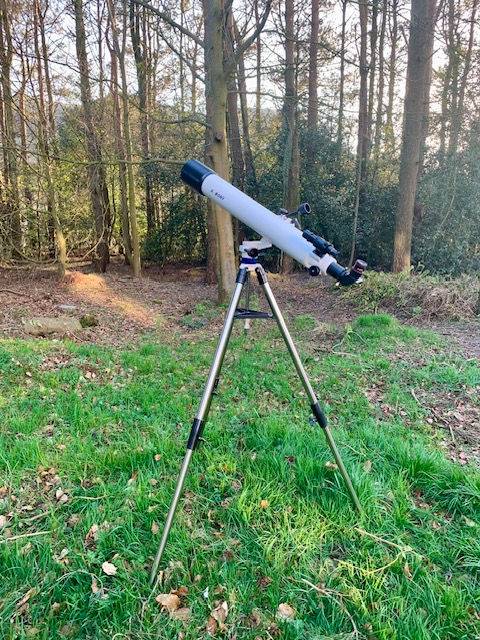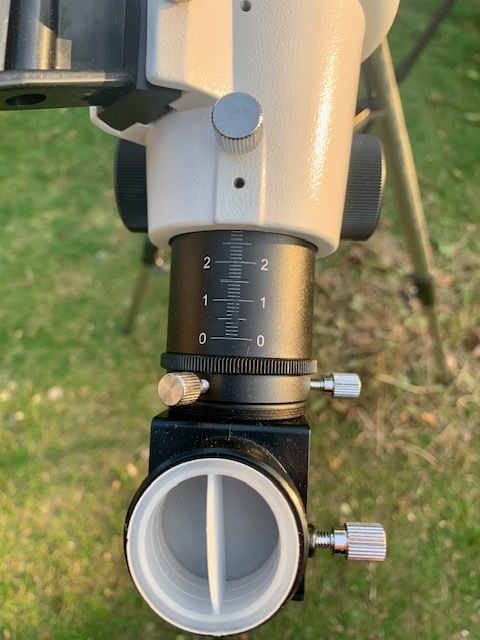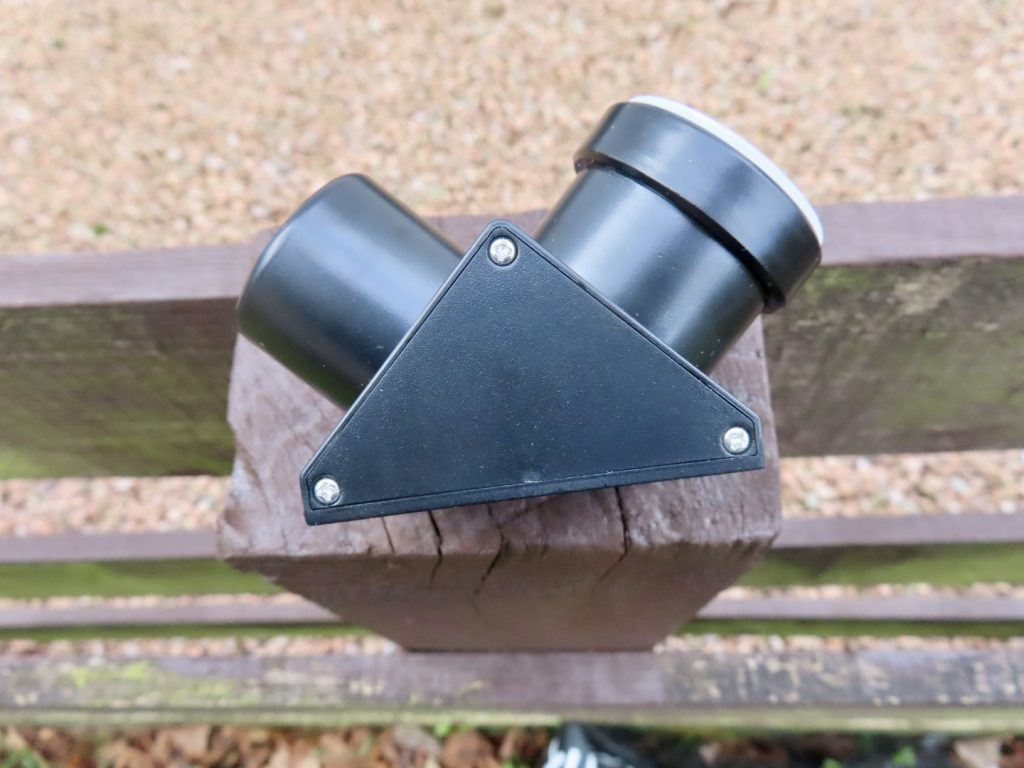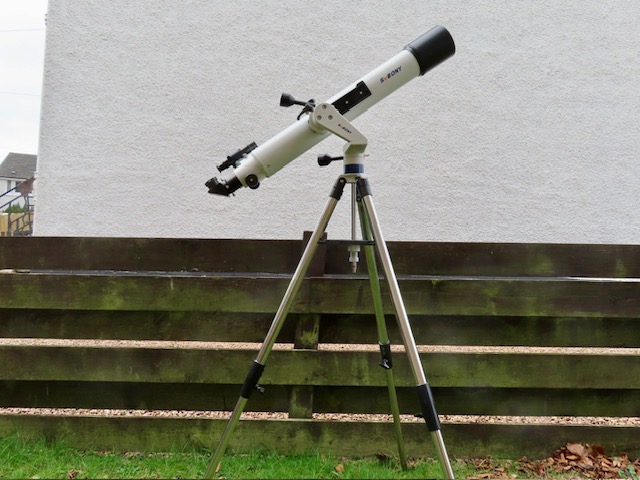
A Work Commenced April 14 2025
When it comes to introducing the wonders of the night sky to beginners, it’s very hard to beat a small refractor. Praised for their crisp, high-contrast views and almost complete lack of maintenance, even absolute newcomers can quickly engage with the night sky. Over the last few years, the newly established company, Svbony, has brought to market very high quality astronomical gear at prices that were considered unthinkable only a few years ago. As a seasoned amateur astronomer, and experienced reviewer of telescopes, I have used Svbony eyepieces and other accessories with my own telescopes and can vouch for their great bang for buck.
Svbony reached out to me to request an honest review of their new entry-level telescope; the SV520 telescope: a 90mm air spaced F/8.9 achromatic refractor on a dedicated altazimuth mount with slow motion controls on both axes. I agreed to do so, and what follows is a fairly detailed overview of its quality and capabilities.

The SV520 telescope, mount and accessories arrived in a well packed double box. Though the instruction manual is clear and comprehensive, I found it easy to assemble the mount and attach the telescope in just a few minutes.

Let’s take a closer look at the telescope mount first. Having used a Vixen Porta II altazimuth mount for nearly 15 years, I was delighted to see that the SV520 came with a very similarly designed unit. It can accept a wide range of small telescopes using a regular dovetail plate. Slow motion controls provide smooth and precise tracking on both axes. The legs of the tripod seem to be made of stainless steel and can be extended to increase the overall height of the telescope for taller users. The legs can be securely locked in place using three large thumbscrews. The accessory tray screws onto the long vertical bar that mates the mount to the tripod legs.

The set up is quite stable with the telescope mounted. After giving it a hefty shake, I found the dampening times to last for just a few seconds, which is more than adequate even when using high power eyepieces. Incidentally the mount can accommodate loads of up to 5 kilos.
Two eyepieces are provided with the optical rube assembly: a 25mm and 10mm Kelner delivering powers of 32x and 80x, respectively. A decent mirror diagonal is also included for comfortable 90 degree viewing. It is not threaded to accept filters though.

The finder was arguably the biggest disappointment in the SV 520 package: a very plasticky 5 x 24mm specification with a singlet objective lens. As you can imagine, it produces very strong colour fringing owing to its short and stubby focal length. But I was able to align it easily with the main telescope and it did serve its purposes as a basic finder scope. Indeed as bad as it is, I think it’s still infinitely better than a generic red dot finder all too often seen on amateur scopes these days.
The SV520 comes with a removable plastic dew shield, which reveals the lens cell underneath. The focuser is a single-speed rack and pinion design, which moves very smoothly and has enough focus travel to use quite a lot of accessories including diagonals, or mounting photographic gear. It can also be rigidly locked in place if need be.
Optical Testing

To be honest, I was expecting good performance from this 90mm f8.9 achromat based on many years experience of long focus 80mm refractors I’ve owned and used over the years. The colour correction ought to be decent: as good in fact as a 4 inch F/10. The two eyepieces supplied with the telescope – a 25mm and 10mm Kellner – deliver powers of 32x and 80x, respectively. The 25x views were very nice. Good on the Moon, star clusters and the brighter nebulae etc. The 10mm Kellner also provided nice views of the Sun using a full-aperture white light solar filter. The slow motion controls on the mount allowed trouble free tracking with dampening times of just a few seconds.

But when I turned the telescope on the stars at 80x, I could immediately see that something was amiss. They were astigmatic. Defocusing the image of Capella both inside and outside focus confirmed this clearly. I was unable to get a good image of Jupiter and double stars were horrid. Clearly there was something wrong with the telescope. Taking out the star diagonal and peering down the tube showed the focuser rail was not parallel with the optical axis.
I did attempt a ‘home fix’ of sorts by removing the dew shield, loosening the retainer ring holding the objective lenses in place and gently wiggling the lenses to see if they would settle into the cell better. Unfortunately, there was no improvement.
Disappointed, I dispatched the telescope to Es Reid, a professional optical engineer based in Cambridge, to see if he could get the optics working better. He confirmed the astigmatism and also noted the objective’s over correction. He added thicker lens spacers and got the focuser to move parallel with the optical tube. When I got the telescope back, I conducted more observations: first a star test at 180x under good seeing conditions. The astigmatism was gone and the intra- and extra-focal Airy disk looked a lot better. Turning the telescope on Jupiter, by now well past its best seasonal position in the sky, showed a much improved image: a few bands were clearly seen. Turning the scope onto Castor in Gemini showed the A and B components with excellent definition at 200x.
Upgrading the diagonal to a dielectric type and using better eyepieces significantly increased the quality of the images of both deep sky objects and higher resolution targets, like the Moon and double stars. Indeed I was now able to press the magnification to 200x or more with good results.
Conclusions:
I understand that Svbony marketed this telescope for beginners, and to some degree, it performed quite well so long as the magnification was not pushed higher than 80x. But even beginners appreciate decent views of the Moon at high powers and for stars to look like pinpoints of light at magnifications above 100x. I don’t know if I received a bad sample or whether this was just a typical example, but Svbony are capable of much better than this. If you’re willing to live with low powers than this would be an OK telescope but, as it was presented to me, I cannot recommend it for those who wish to push the envelope a little to tease out powers of 200x or a little higher.
Neil English is author of Choosing and Using a Refracting Telescope.
Interesting review.
I thought about buying the Svbony sv520 for a while but in the end I purchased the Skywatcher 90/910 mm f10 achromat. It looks like it was a good decision because by Skywatcher 90/910 mm really impressed me with it’s optical quality, it’s very sharp even at 227.5x magnification (4 mm eyepiece), which is fantastic for a cheap achromat. I also have the Svbony 102/714 mm ED, the Skywatcher 90/910 mm is optically almost as good. The difference is small between the two. The Svbony 102/714 mm ED is a little brighter, has a little less chromatic aberration, the sharpness is practically the same. Overall optically the difference is very small between the two. I was really impressed with the optical performance of the Skywatcher 90/910 mm achromat. I could even see around 30 galaxies with it from a bortle 6 city. And it was just 266 euro with AZ3 mount, tripod and accessories in my country Romania. The price / performance ratio is fantastic in my opinion. The AZ3 mount on the other hand isn’t that great, it’s usable but annoying. The eyepieces and diagonal are on the cheap side but still acceptable .
Can you please tell me the height if the sv225T tripod when fully extended?
Clear skies and greetings from Romania!
Hello Paul,
Thanks for your comments. The SV520 was rather disappointing. It should have done much better. The Skywatcher 90mm F/10 sounds like a fine scope. I’ve never tried it though.
The tripod extends to about 1.5m .
Best wishes,
Neil.